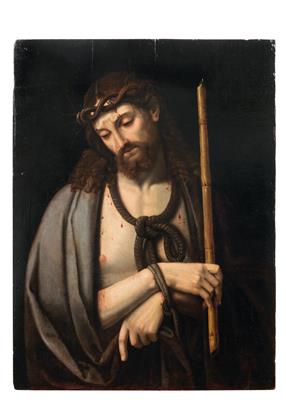Workshop of Andrea Solario

(Milan circa 1470–1524)
Ecce Homo,
oil on panel, 66 x 49.5 cm, framed
Provenance:
Private European collection;
where acquired by the present owner
At least two autograph versions of the present composition by Andrea Solario are known, both of which David Alan Brown dates to circa 1507-1509, to the end of Solario’s French sojourn: one is in the John G. Johnson Collection, Philadelphia, which is considered to be the primary version, and the other is conserved in the Museum der Bildenden Künste, Leipzig (see D. A. Brown, Andrea Solario, Milan 1987, cat. nos. 50, 51). Another version was offered at Sotheby’s, London, on 7 December 2011, lot 4.
The present work is painted on an oak panel, an unusual support for an Italian artist but one that was widely used in France at the time. The use of oak panels as a support appears to be significantly recurrent in Solario’s work. The previously mentioned Ecce Homo in Philadelphia is also painted on oak and it is inscribed on the reverse with the arms of the Rouillé d’Orfeuil family from Normandy. Thereby implying that the composition was executed in France, when Solario was employed by Cardinal Georges I d’Amboise.
The present Ecce Homo shows Christ with his head bent in resignation, and his body marked by flagellation. The Ecce Homo is characteristic of the softer, more graceful and naturalistic style that gradually replaced the exacting precision of Solario’s youthful works. It combines the emotive power of the northern masters, as well as Antonello da Messina, whose finely detailed devotional images Solario would have seen in Milan, Venice and indeed in France, with stylistic influences also from Leonardo da Vinci.
Esperto: Mark MacDonnell
 Mark MacDonnell
Mark MacDonnell
+43 1 515 60 403
old.masters@dorotheum.com
10.11.2020 - 16:00
- Prezzo realizzato: **
-
EUR 23.160,-
- Stima:
-
EUR 30.000,- a EUR 40.000,-
Workshop of Andrea Solario
(Milan circa 1470–1524)
Ecce Homo,
oil on panel, 66 x 49.5 cm, framed
Provenance:
Private European collection;
where acquired by the present owner
At least two autograph versions of the present composition by Andrea Solario are known, both of which David Alan Brown dates to circa 1507-1509, to the end of Solario’s French sojourn: one is in the John G. Johnson Collection, Philadelphia, which is considered to be the primary version, and the other is conserved in the Museum der Bildenden Künste, Leipzig (see D. A. Brown, Andrea Solario, Milan 1987, cat. nos. 50, 51). Another version was offered at Sotheby’s, London, on 7 December 2011, lot 4.
The present work is painted on an oak panel, an unusual support for an Italian artist but one that was widely used in France at the time. The use of oak panels as a support appears to be significantly recurrent in Solario’s work. The previously mentioned Ecce Homo in Philadelphia is also painted on oak and it is inscribed on the reverse with the arms of the Rouillé d’Orfeuil family from Normandy. Thereby implying that the composition was executed in France, when Solario was employed by Cardinal Georges I d’Amboise.
The present Ecce Homo shows Christ with his head bent in resignation, and his body marked by flagellation. The Ecce Homo is characteristic of the softer, more graceful and naturalistic style that gradually replaced the exacting precision of Solario’s youthful works. It combines the emotive power of the northern masters, as well as Antonello da Messina, whose finely detailed devotional images Solario would have seen in Milan, Venice and indeed in France, with stylistic influences also from Leonardo da Vinci.
Esperto: Mark MacDonnell
 Mark MacDonnell
Mark MacDonnell
+43 1 515 60 403
old.masters@dorotheum.com
|
Hotline dell'acquirente
lun-ven: 10.00 - 17.00
old.masters@dorotheum.at +43 1 515 60 403 |
| Asta: | Dipinti antichi |
| Tipo d'asta: | Asta in sala con Live Bidding |
| Data: | 10.11.2020 - 16:00 |
| Luogo dell'asta: | Wien | Palais Dorotheum |
| Esposizione: | 04.11. - 10.11.2020 |
** Prezzo d’acquisto comprensivo dei diritti d’asta acquirente e IVA
Non è più possibile effettuare un ordine di acquisto su Internet. L'asta è in preparazione o è già stata eseguita.
